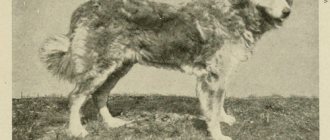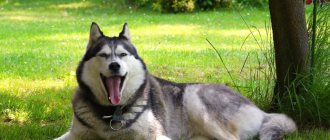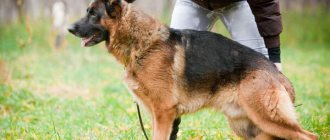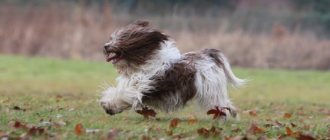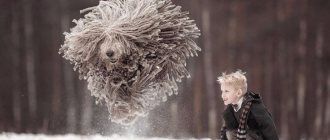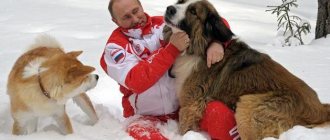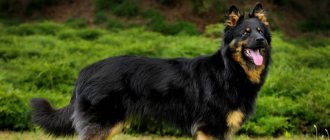The long-haired German Shepherd was officially recognized in 2010.
Before this, a German Shepherd with a coat longer than the standard length was considered a defective breed.
However, the long-haired variety is currently becoming popular.
What is the secret of this breed, which is gaining popularity all over the world? And what do people who decide to buy such a dog need to know?
Origin story
Dogs similar to modern German Shepherds were mentioned in German chronicles of the 7th century AD. In them they are described as large and strong animals, predominantly light in color. It is quite possible that it was among them that long-haired individuals first began to appear.
Dark colors in shepherd dogs appeared much later - in the 17th and 18th centuries. But even then it was impossible to talk about them as a separate breed - they were working dogs, very diverse in their type of build, color and length of coat.
But by the middle of the 19th century, two types of shepherd dogs were bred in Germany. More massive and squat dogs were assistants to farmers in Central and Northern Germany. And in the south of the country, shepherd dogs with a different type of build were bred - lighter and more graceful. All of them were distinguished by excellent working qualities, they were quite angry, but at the same time, balanced and controllable.
Thus, by the time targeted work on the breed began, Germany already had a good number of dogs, which gave rise to the German Shepherd breed.
The founder of the “Germans” was the German breeder Max von Stefanitz. He not only was engaged in breeding work to breed a certain average type of German shepherds, which would embody their best exterior and working qualities, but also developed the first breed standard.
NOTE!
After the standard was developed in 1899, it took only a few years for the German Shepherd to become a recognized police and military dog.
Origin
Initially, long-haired shepherd dogs were considered defective. Their puppies were not even recognized at shows. It was impossible to control the birth
with thick and long hair, because such dogs could have been born to ordinary short-haired parents. Where the gene responsible for such hair came from is still not clear.
One thing is known - long-haired German shepherds began to be perceived and valued as purebreds only at the beginning of the 20th century, or more precisely in 2010. Then the standards for this shaggy breed were introduced, and it received its pedigree. Previously, such animals were sold without a pedigree document.
In general, this breed originated from the German Shepherd. And that, in turn, began to exist as a separate breed in the 18th century. At this time, Max von Stefanitz, a veterinarian by training, decided to develop a completely new superior breed. In his opinion, the animal had to have good guarding qualities and at the same time be well-mannered. In 1899, Max noticed these characteristics in one of the male dogs at an exhibition, and bought the dog from the owner. Cable Hector became the progenitor of the modern German Shepherd.
Description of the breed
In appearance, the long-haired German Shepherd is similar to the short-haired Shepherd. This is a large, harmoniously built, strong, agile and muscular dog of a rather elongated format.
The German Shepherd is considered a universal service breed, as it is suitable for a wide variety of work - it can be a bloodhound, a watchman, a rescuer, a guide for the blind, and a shepherd's assistant.
Character traits
The long-haired German Shepherd has a less balanced temperament than short-haired dogs.
Some of the so-called “long-liners” are characterized by excessive excitability and nervousness. If such a dog gets carried away with something, it can be very difficult to stop him.
There are also long-haired German Shepherds that are extremely phlegmatic. These dogs are not very fond of outdoor games and training and may even seem lazy.
At home, longhaired shepherds are usually friendly and sweet towards their owners. But dogs with a phlegmatic character show apparent indifference to attempts by family members to play with them or pet them. And choleric, overly excitable dogs act according to their mood - if they are in a good-natured mood, they can come and begin to caress people, but if they are not in the mood, they can growl and snap.
IMPORTANT!
Such behavioral features can be corrected by correct and timely training, but most often it is not possible to completely change the character and temperament of a long-haired German Shepherd to suit oneself.
Other colors of German Shepherds
Each breed of dog has shades of coat that are included in the standard description or that are unusual for a particular breed. German Shepherds are no exception. The standard includes only 4 colors, while there are many more non-standard colors.
Standard
In addition to the basic saddle color, pets can be standardly zonal in color, jet black or black and tan. In all cases, except coal, small tan areas with red hair are allowed. Black representatives of the breed should have dark fur, as well as dark claws, nose and eyes. Otherwise, the puppy is rejected.
Unusual
Non-standard shades of wool include absolutely white. But such dogs are not considered albinos. Their snow-white fur is harmoniously combined with a black nose and dark claws, as well as brown eyes. Also unusual colors include spotted and roan pets. Additionally, Shepherds can be completely gray or tan with varying intensities of color.
Despite the variety of shades, all shepherd dogs without exception have good characteristics. They are excellent companions and guards, watchmen and search engines. These are universal dogs suitable for any level of owner training.
Similar articles
Accepted standard
The height at the withers for males is 60-65 cm, and for females - 55-60 cm. Weight is 30-40 kg for boys and 22-32 kg for girls.
Other standard characteristics of dogs:
- the head is proportional, looks wedge-shaped from above - widened in the cranial part, but tapering towards the nose. The forehead is slightly convex, the stop is smooth, the cheekbones are weakly defined;
- the length of the muzzle is approximately equal to ½ of the total length of the head;
- the ears are medium in size, erect, set high, in the form of a triangle with a wide base;
- The eyes are oval, medium size, dark brown. The nose is quite large and black;
- the neck is strong and muscular, of medium length, without dewlap;
- the withers are well defined, the back is elongated but strong. The croup has a clearly visible slope;
- The chest is oval, quite deep and powerful. The abdomen is moderately tucked;
- The forelimbs are parallel and straight. The hindquarters are covered with well-developed muscles, straight, and slightly pulled back when standing;
- saber-shaped tail, abundantly overgrown with hair.
The main external feature of the long-haired German Shepherd, which makes it unlike short-haired dogs, is its shaggy and thick coat, which forms fringes on the ears, paws and tail.
Expert opinion
Kozhevin Semyon Kirillovich
Expert dog handler.
The long-haired German Shepherd is a strong and hardy working dog, outwardly no different from an ordinary short-haired shepherd except for the type of coat. But these two breed varieties have differences in character and temperament. Despite the fact that most “long dogs” are calm and balanced dogs, among them there are both overly phlegmatic and choleric individuals. In any case, having decided to purchase a long-haired German Shepherd, you need to be as responsible as possible in choosing the breeder and the puppy itself.
The diagram below shows the ideal proportions for a shepherd.
Breed standard and description
Polish Podgalian Sheepdog: description of the dog breed
The description of the first representatives of the breed was radically different from what kind of dogs people are used to seeing today. Both literate and illiterate breeders contributed to this change, as did the division of dogs into show and working dogs.
Note! Male BUT should be 60-65 cm at the withers and weigh from 30 to 40 kg. In females, these parameters vary from 55 to 65 cm in height with 22-32 kg of weight.
The dog's head resembles a wolf's, it is slightly elongated. On the top of the head there are erect ears of medium size. The eyes are brown. Scissor bite. The neck is massive, sits tightly on the shoulders. The paws are strong, but not heavy. The body of show breeding dogs is slightly longer, the withers are much higher than the pelvis (sloping back). In dogs of working breeding, this slope is not so pronounced or absent.
The long-haired shepherd, like the short-haired one, can come in several colors. As a rule, it is black-backed (red body with darkening on the back and muzzle). But there are also variations with gray and black colors. White color is rejected (white BUTs are called Swiss Shepherds). The dog's nose is always black. The black long-haired German Shepherd looks especially elegant.
Popular types
Based on their coat type, long-haired German Shepherds are divided into two types:
- dogs with long, coarse hair . The coat is coarse, rather hard and does not adhere to the dog’s body. Forms feathering on the front and hind legs, as well as on the ears and tail;
- dogs with rather soft, long hair . The long and fluffy hair lies like a light wave on the back, forms dewlaps and feathers on all limbs, on the ears and on the tail.
Brief history of the origin of the breed
The breed has been known since the beginning of the 20th century. Previously, shepherd dogs with long hair were considered a waste ; such puppies were not recognized anywhere. But it was impossible to control the appearance of such puppies, since they could also be born to dogs with short hair. Many dog breeders came to the conclusion that the long pile and sparse undercoat are a developmental defect and began to cull these dogs. Some breeders claimed that they were unfit for work due to their small undercoat.
For a long time, such shepherd dogs were not recognized by breeders and breeders, but the situation changed in 1984. The first club of long-haired German shepherds appeared. Today there are many such clubs all over the world. Many dog breeders breed only these shepherd dogs. The breed has gained many fans. In 2010, the breed standard was officially adopted.
Photos of dogs with basic colors
The main colors of the long-haired German Shepherd are black and red, black and black. A black mask on the face is desirable.
Examples of colors are shown in the photo below.
Advantages and disadvantages
Pros:
- long hair that forms fringes gives these dogs a very beautiful and even elegant look;
- trainees;
- exceptionally devoted;
- unpretentious in maintenance and feeding;
- clearly understand the difference between work and everyday life;
- wonderful security guards;
- Suitable for any sport or service.
NOTE!
A balanced temperament and the ability to instantly get involved in work and just as quickly move to a normal, “non-working” state is one of the main advantages of most long-haired German shepherds.
Minuses:
- these dogs need serious training;
- “long-liners,” especially those with a choleric temperament, need great physical exertion;
- this dog must be “in business”;
- may be too aggressive;
- during shedding there is a lot of wool in the house;
- predisposition to allergies and dysplasia.
How to choose a puppy and cost
The price of a puppy can vary greatly depending on many factors and even the place of purchase. So, for example, a purebred baby of breeding class (for breeding) will cost from 3,000 to 65 thousand rubles. Show-class puppies are the most expensive; a baby from good parents can cost from 65 thousand to 550 thousand rubles*
Important! Buying a pet-class puppy is a rather risky decision. A baby without documents and a passport could easily turn out to be a mongrel.
When meeting puppies, you should pay attention to their activity and appearance (there should not be a lot of white fur). Parents must have a pedigree and documents, just like puppies.
How does it relate to children and pets?
Long-haired German Shepherds tolerate children, but if they begin to annoy them too much, they may snap at them.
Relationships with other pets living in the same house with them develop differently. They agree to tolerate cats, provided that they themselves do not pester them. Other dogs are tolerated, but not too favored.
Is it suitable for keeping outdoors and in an apartment?
The German Shepherd feels best in a private home. Their long fur allows them to stay warm even in cold weather. But it is important to remember that in winter the shepherd will need an insulated booth.
A long-haired shepherd dog can live in an apartment if you take it for a walk at least twice a day. Walks should be quite long and active. However, you need to remember that German Shepherds kept in an apartment shed heavily.
In addition, these dogs react very sensitively to the slightest noise and can bark in the absence of their owners.
Life expectancy and health
The average life expectancy is 10-14 years.
In general, the Longhaired German Shepherd is a relatively healthy breed, but members may be predisposed to the following diseases :
- dysplasia;
- diseases of the digestive system;
- allergy;
- dermatitis;
- otitis.
The long-haired German Shepherd can be prone to mental disorders, which is why its behavior can be either hyperactive and overly excitable, or inhibited.
Diseases and life expectancy
Typically, Hairy Shepherds live 10-13 years. Life expectancy depends on many factors. It is influenced by living conditions, activity, nutrition, genes.
This dog can live more than 10 years
A disease that accompanies all large breeds of dogs - hip dysplasia - is a real scourge of the “Germans”. Show-bred dogs are most susceptible to it due to their special croup structure and low back. The disease manifests itself in most adult shepherd dogs.
Basic rules of care
Every day it is necessary to examine your pet's ears, eyes and teeth and, if necessary, clean them.
The dog needs to be brushed 3-4 times a week, and during the molting period - once a day. At the same time, if the hair sheds a lot, it is better to use a furminator rather than a brush.
The German Shepherd usually grinds its claws down on its own during walks. To clean teeth, it is recommended to give your dog special treats or toys to chew on.
You need to bathe your dog no more than once every 2-3 months. It is recommended to wash your dog only with shampoo specifically designed for animals.
Read more about caring for a German Shepherd here.
Education and training
raised by a self-confident and strong person who can explain to the dog from the first day of its appearance in the house who the leader of the “pack” is.
You cannot indulge the dog’s whims, because once you give the puppy free rein, then it will be very difficult to call the shepherd to order.
From the very beginning, it is necessary to determine that the pet should never be allowed under any circumstances, and all family members without exception must strictly ensure that the dog does not violate these prohibitions.
For example, it is completely unacceptable to allow a dog to growl at its owners, or even more so, to try to bite them. You should also discourage begging near the table and the habit of sleeping on the sofa or bed.
IMPORTANT!
From the very beginning, you need to start socializing the puppy so that he understands once and for all that without the owner’s command he cannot bark at strangers, much less attack them. The same applies to the attitude towards other animals - the shepherd dog should not see them as enemies or potential prey.
At the age of 4 months, you can begin to teach your pet a general course of training. You should move on to more serious activities when the dog grows up. At the same time, your pet should be taught protective or detection skills under the guidance of a professional.
Character and training
The long-haired German Shepherd is a fast and flexible, athletic and fit dog. The profile is strong-willed and strong. This breed is represented by large, strong individuals, excellent defenders and guards.
Temperament
A dog of this breed is ideal in everything ; it adapts perfectly to any living conditions. A strong and stable nervous system, good health and high intelligence make it universal.
Shepherd dogs are actively involved in military and police activities, working as rescuers and security guards.
A German Shepherd can be safely adopted in a family with small children . The animal is kind and gentle towards young children, and if necessary, it will always protect them. A dog will also be an ideal companion for a lonely person. Natural courage and courage allow you to remain without your owner for a long time and wait patiently for him. They are not characterized by barking for no reason and damaging household property.
From the first days of appearing at home, the pet intuitively chooses a leader whom it will obey unquestioningly throughout its life.
Upbringing
The rules for raising a German longhaired shepherd are no different from raising an ordinary shepherd. The animal grows large, so her obedience is very important. An untrained shepherd can be dangerous to others. From the first days a dog appears in the house, you need to gradually begin to train it .
The first rule that a puppy must understand is its name and place . The dog should not be allowed to sleep on the sofa, bed, and especially with its owner. The shepherd will grow big, so it should have its own free place to sleep and rest. The general course of training should begin when the animal is six months old.
Nature has endowed these dogs with high trainability, performance and intelligence. It is necessary to raise a dog. With each stage of training, dogs acquire new skills and intelligence develops. Many representatives of this breed have a heroic past.
It happens that difficulties arise during the learning process, then they resort to the help of a specialist. He will select a training and training program. If the dog easily masters the general training course, then in the future you can proceed to more serious training methods.
How and what to feed?
fed either high-quality food for large active dogs or a balanced natural food.
If your dog eats ready-made food, it is better to choose a hypoallergenic one based on lamb, rabbit or turkey. Considering the predisposition of shepherd dogs to dysplasia, we can recommend feeding a pet of this breed with ultra-premium class .
A homemade diet should be based on animal protein products, such as beef, lamb or turkey. Buckwheat and rice are suitable cereals for the shepherd dog. It is useful to supplement your dog’s diet with vegetables and fruits, and preference should be given to seasonal ones.
As a treat, you can feed finely chopped and dried bread.
It is necessary to give your shepherd fermented milk products - kefir, low-fat yogurt, cottage cheese. They are especially useful for growing puppies.
What do the puppies look like?
Long-haired German Shepherd puppies are born with slightly wavy hair, but by the age of one month it is more or less straightened and begins to fluff, which is why such puppies are immediately noticeable, especially if they were born in a litter of short-haired dogs.
The color of a small “German” at this age will most likely be black and tan, which will become larger and larger as the pet grows, until finally the dog completely fades. Black and black-fawn puppies will change color, if at all, then only slightly.
A small shepherd dog may have disproportionately large paws, and ears that fall to one side or remain drooping. You should not be afraid of this - the paws will begin to appear smaller when the dog grows a little, and the ears will begin to rise at about 3 months .
How to choose your future pet?
Since the German Shepherd is a very serious dog, you only need to buy a pet of this breed with documents of origin. In addition, the puppy's parents must have medical certificates confirming the absence of dysplasia.
Nowadays, most long-haired German Shepherds have become show dogs, so if you need to find a working shepherd with this type of coat, you may have to spend a lot of time searching for a suitable baby.
NOTE!
You can buy a German Shepherd from the age of two months. If you pick up the puppy earlier, he will not get the necessary experience of communicating with other dogs, which means there will be problems with his socialization.
Before you go for a puppy, you need to finally decide not only on the gender and color, but also on the most desirable type of temperament. And, if you just need a companion, and not a guard dog, you should not choose a baby that shows aggression towards people or towards the mother and littermates.
It is also very important that the puppy is sufficiently well-fed and large, but not excessively. If a dog is bought for exhibitions, then it is better to choose a medium-sized baby, as it is more likely to grow into a standard-sized dog. And, of course, the chosen puppy must be completely healthy and should not have even the slightest signs of illness.
More complete information about the rules for choosing a German Shepherd puppy can be found here.
Character, training and education
In the process of establishing the breed, the breeders did their best and turned the shepherd into a truly universal breed. She has protective and guard qualities, she is well oriented towards people, learns quickly, and understands her owner perfectly. Such a dog is a real find even for a novice owner, as she has an easy-going character.
Puppy BUT requires daily attention
When properly trained, long-haired shepherd dogs grow up to be kind and playful dogs. They love active games with their owner, but they can also adapt to short-term solitude. If you establish contact with the puppy, in the future he will be easily trained and will learn to understand the intonations of the owner. To do this, you need to spend a lot of time with the dog, both on walks and at home. You should not leave your puppy to his own devices or always let him play with other dogs on the street. Contact with the owner is the key to understanding.
Note! You can train a shepherd dog from the age of two to three months. Such basic commands as “sit”, “lie down”, “come to me”, “take your place”, “ugh!” must be mastered without fail. You can reward your puppy with a toy, a treat, and lots of praise. It is better to ignore unwanted behavior rather than punish it.
